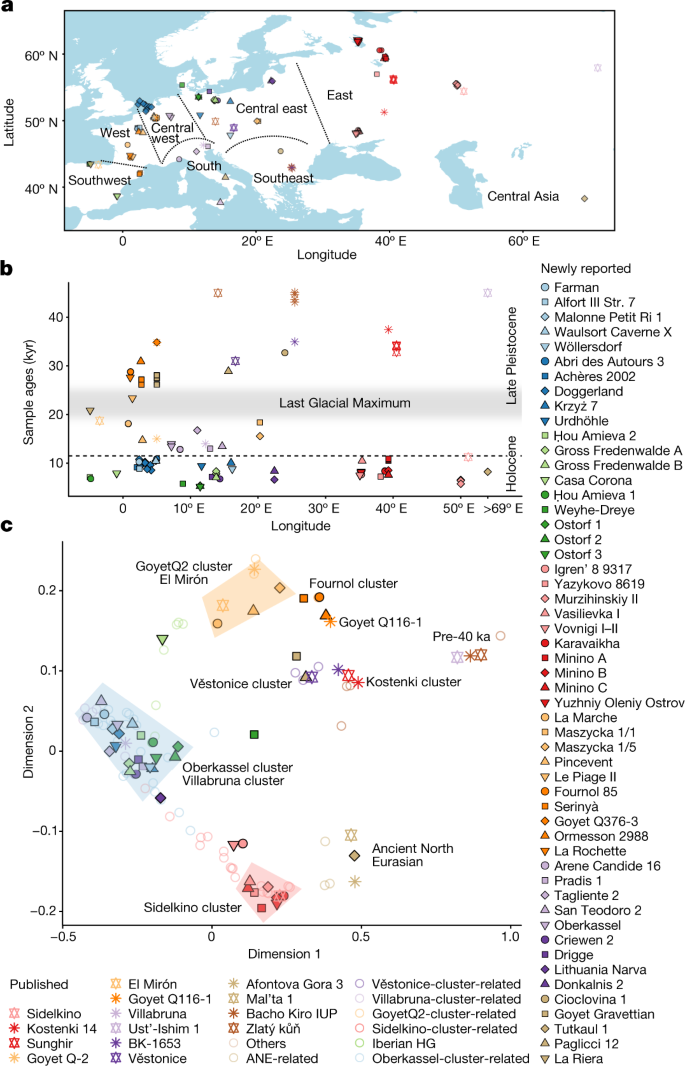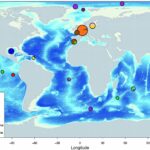大規模ゲノム解析により、氷河期の狩猟採集民の3万年にわたる移動が Large-scale genomic analysis documents the migrations of Ice Age hunter-gatherers over a period of 30,000 years
2023-03-01 マックス・プランク研究所
特に、32,000年前から24,000年前にヨーロッパで広まったグラヴェッティ文化を持つ人々について、中央と南ヨーロッパのグラヴェッティ人と、フランスとイベリア半島のグラヴェッティ人とは文化的には似ていたが、遺伝子的には異なっており、後者の系統が今日の西ヨーロッパの祖先となっていることが明らかになった。また、最後の氷河期の最中における西ヨーロッパの人口について、その遺伝子情報から、温暖で過ごしやすい地域に避難していたことが示唆された。
さらに、紀元前14,000年ごろにヨーロッパで急速に暖かくなる時期があった際、南から北上する人々によって、マグダレニアン文化の人々を含め、大規模な人口置換が起きたことも判明した。
<関連情報>
- https://www.mpg.de/19941740/0223-evan-ice-age-survivors-150495-x?c=2249
- https://www.nature.com/articles/s41586-023-05726-0
後期旧石器時代から新石器時代のヨーロッパ狩猟採集民のパレオゲノミクス Palaeogenomics of Upper Palaeolithic to Neolithic European hunter-gatherers
Cosimo Posth,He Yu,Ayshin Ghalichi,Hélène Rougier,Isabelle Crevecoeur,Yilei Huang,Harald Ringbauer,Adam B. Rohrlach,Kathrin Nägele,Vanessa Villalba-Mouco,Rita Radzeviciute,Tiago Ferraz,Alexander Stoessel,Rezeda Tukhbatova,Dorothée G. Drucker,Martina Lari,Alessandra Modi,Stefania Vai,Tina Saupe,Christiana L. Scheib,Giulio Catalano,Luca Pagani,Sahra Talamo,Helen Fewlass,Laurent Klaric,André Morala,Mathieu Rué,Stéphane Madelaine,Laurent Crépin,Jean-Baptiste Caverne,Emmy Bocaege,Stefano Ricci,Francesco Boschin,Priscilla Bayle,Bruno Maureille,Foni Le Brun-Ricalens,Jean-Guillaume Bordes,Gregorio Oxilia,Eugenio Bortolini,Olivier Bignon-Lau,Grégory Debout,Michel Orliac,Antoine Zazzo,Vitale Sparacello,Elisabetta Starnini,Luca Sineo,Johannes van der Plicht,Laure Pecqueur,Gildas Merceron,Géraldine Garcia,Jean-Michel Leuvrey,Coralie Bay Garcia,Asier Gómez-Olivencia,Marta Połtowicz-Bobak,Dariusz Bobak,Mona Le Luyer,Paul Storm,Claudia Hoffmann,Jacek Kabaciński,Tatiana Filimonova,Svetlana Shnaider,Natalia Berezina,Borja González-Rabanal,Manuel R. González Morales,Ana B. Marín-Arroyo,Belén López,Carmen Alonso-Llamazares,Annamaria Ronchitelli,Caroline Polet,Ivan Jadin,Nicolas Cauwe,Joaquim Soler,Neus Coromina,Isaac Rufí,Richard Cottiaux,Geoffrey Clark,Lawrence G. Straus,Marie-Anne Julien,Silvia Renhart,Dorothea Talaa,Stefano Benazzi,Matteo Romandini,Luc Amkreutz,Hervé Bocherens,Christoph Wißing,Sébastien Villotte,Javier Fernández-López de Pablo,Magdalena Gómez-Puche,Marco Aurelio Esquembre-Bebia,Pierre Bodu,Liesbeth Smits,Bénédicte Souffi,Rimantas Jankauskas,Justina Kozakaitė,Christophe Cupillard,Hartmut Benthien,Kurt Wehrberger,Ralf W. Schmitz,Susanne C. Feine,Tim Schüler,Corinne Thevenet,Dan Grigorescu,Friedrich Lüth,Andreas Kotula,Henny Piezonka,Franz Schopper,Jiří Svoboda,Sandra Sázelová,Andrey Chizhevsky,Aleksandr Khokhlov,Nicholas J. Conard,Frédérique Valentin,Katerina Harvati,Patrick Semal,Bettina Jungklaus,Alexander Suvorov,Rick Schulting,Vyacheslav Moiseyev,Kristiina Mannermaa,Alexandra Buzhilova,Thomas Terberger,David Caramelli,Eveline Altena,Wolfgang Haak & Johannes Krause
Nature Published:01 March 2023
DOI:https://doi.org/10.1038/s41586-023-05726-0

Abstract
Modern humans have populated Europe for more than 45,000 years1,2. Our knowledge of the genetic relatedness and structure of ancient hunter-gatherers is however limited, owing to the scarceness and poor molecular preservation of human remains from that period3. Here we analyse 356 ancient hunter-gatherer genomes, including new genomic data for 116 individuals from 14 countries in western and central Eurasia, spanning between 35,000 and 5,000 years ago. We identify a genetic ancestry profile in individuals associated with Upper Palaeolithic Gravettian assemblages from western Europe that is distinct from contemporaneous groups related to this archaeological culture in central and southern Europe4, but resembles that of preceding individuals associated with the Aurignacian culture. This ancestry profile survived during the Last Glacial Maximum (25,000 to 19,000 years ago) in human populations from southwestern Europe associated with the Solutrean culture, and with the following Magdalenian culture that re-expanded northeastward after the Last Glacial Maximum. Conversely, we reveal a genetic turnover in southern Europe suggesting a local replacement of human groups around the time of the Last Glacial Maximum, accompanied by a north-to-south dispersal of populations associated with the Epigravettian culture. From at least 14,000 years ago, an ancestry related to this culture spread from the south across the rest of Europe, largely replacing the Magdalenian-associated gene pool. After a period of limited admixture that spanned the beginning of the Mesolithic, we find genetic interactions between western and eastern European hunter-gatherers, who were also characterized by marked differences in phenotypically relevant variants.


